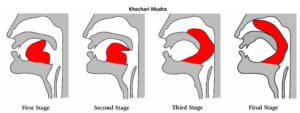Khechari Mudra
Introduction
Khechari Mudra is one of the most advanced and revered mudras in Hatha Yoga. It is mentioned in ancient texts like the Hatha Yoga Pradipika, Gheranda Samhita, and Shiva Samhita. It is classified as a Maha Mudra (great seal) and is deeply associated with higher states of consciousness, spiritual awakening, and the control of prana (life energy).
The practice involves rolling the tongue back and upward into the nasal cavity to stimulate higher brain centers and activate the pineal gland. It is believed to help transcend hunger, thirst, sleep, and achieve deep states of meditation (samadhi).
Meaning
Sanskrit:
Khe = sky/space/ether
Chari = moving or roaming
Thus, Khechari Mudra means “the gesture of moving in the inner space (sky)” – symbolic of roaming the infinite consciousness.
How to Perform (Method of Practice)
Preparation:
Traditionally, aspirants were trained gradually, sometimes with the practice of talabya kriya (tongue-stretching exercise).
Beginners should not attempt the full mudra without guidance.
Steps:
Sit in a meditative posture such as Padmasana, Siddhasana, or Vajrasana with spine erect.
Close the eyes and relax the body.
Roll the tongue backward and upward to touch the soft palate.
With advanced practice, extend the tongue further into the nasopharyngeal cavity, reaching toward the uvula and eventually into the nasal passages.
Focus your gaze inward (Shambhavi mudra can be combined).
Begin slow, deep breathing – or practice Kevala Kumbhaka (breath suspension) if trained.
Meditate on the Ajna Chakra (third eye) or Sahasrara (crown).
Benefits
Physical Benefits
Stimulates saliva production (amrita secretion) which is believed to be rejuvenating.
Strengthens tongue and throat muscles.
Reduces hunger and thirst sensations.
Helps in control of the endocrine system (pituitary & pineal activation).
Mental & Emotional Benefits
Induces deep states of calmness, tranquility, and concentration.
Reduces stress, anxiety, and restlessness.
Enhances mental clarity and memory.
Spiritual Benefits
Facilitates Kundalini awakening by sealing prana within the body.
Assists in achieving Samadhi (superconscious state).
Said to allow the practitioner to drink the divine nectar (amrita) secreted from higher brain centers.
Helps transcend body limitations like hunger, thirst, and sleep during meditation.
Contraindications
Should not be practiced by beginners without a teacher.
Not recommended for those with tongue, throat, or nasal abnormalities/infections.
Avoid if you suffer from epilepsy, psychiatric conditions, or uncontrolled hypertension.
Do not attempt aggressive tongue-cutting practices mentioned in old texts (dangerous).
Anatomy & Physiology
Involves tongue flexion and elongation using genioglossus, styloglossus, and hyoglossus muscles.
Pressure is applied to the soft palate, uvula, and nasopharynx stimulating cranial nerves (especially glossopharyngeal & vagus nerves).
Stimulates the pituitary and pineal glands, influencing hormonal balance.
Activates parasympathetic nervous system → deep relaxation.
Kinesiology
Requires strong lingual muscle control.
The backward rolling of the tongue creates an isometric stretch.
Helps in developing orofacial neuromuscular coordination.
Encourages stability in the head-neck region during meditation.
Neurology
Stimulation of cranial nerves IX (glossopharyngeal) and X (vagus) → calming effect on autonomic functions.
Activates the limbic system → emotional regulation.
Stimulates pineal gland (melatonin regulation) and possibly DMT-related experiences in advanced yogis.
Supports neuroplasticity by training unusual tongue movements.
Duration of Practice
Beginners (initial stage): 1–3 minutes (just touching soft palate).
Intermediate: 5–15 minutes, progressing deeper into nasal cavity.
Advanced yogis: Can sustain for hours in meditation, combined with pranayama.
Counter Mudra
Matsya Mudra (Fish Gesture): Cooling and restorative.
Hridaya Mudra: Emotional balance after intense energy work.
Chin Mudra or Jnana Mudra: Grounding and stabilizing after higher practices.
Conclusion
Khechari Mudra is considered the king of mudras in Hatha Yoga – a gateway to samadhi, kundalini awakening, and immortality of consciousness. While modern science explains its effects on the nervous and endocrine systems, its true depth lies in spiritual transformation. It requires discipline, patience, and guidance from a realized teacher.
FAQ
Q1: Can beginners practice Khechari Mudra?
Beginners should only practice the first stage (touching the soft palate) under guidance.
Q2: Is tongue-cutting necessary as some texts say?
No. Modern yoga discourages this dangerous practice. Gradual stretching through talabya kriya is safe.
Q3: What is the main spiritual effect?
It is believed to allow the yogi to drink the nectar of immortality (amrita) and reach deep states of meditation.
Q4: Does it stop hunger and thirst?
Yes, advanced practitioners report reduced hunger, thirst, and need for sleep.
Q5: Which chakras are influenced?
Primarily Ajna (third eye) and Sahasrara (crown chakra).
References
Hatha Yoga Pradipika – Swatmarama.
Gheranda Samhita.
Shiva Samhita.
Satyananda Saraswati – Asana, Pranayama, Mudra, Bandha.
Georg Feuerstein – The Yoga Tradition.
James Mallinson & Mark Singleton – Roots of Yoga.
